Buriti Fabric Reinforced Epoxy Composites as a Novel Ballistic Component of a Multilayered Armor System
Abstract
:1. Introduction
2. Materials and Methods
2.1. Composite Manufacturing
2.2. Ballistic Tests
2.3. Statistical Analysis
2.4. Scanning Electron Microscopy (SEM)
3. Results and Discussion
3.1. Multilayered Armor System (MAS)
3.2. Stand-Alone Ballistic Tests
3.3. Scanning Electron Microscopy (SEM) Failure Analyses
4. Summary and Conclusions
Author Contributions
Funding
Institutional Review Board Statement
Informed Consent Statement
Data Availability Statement
Acknowledgments
Conflicts of Interest
References
- Zhao, Z.; Liu, W.; Jiang, Y.; Wan, Y.; Du, R.; Li, H. Solidification of heavy metals in lead smelting slag and development of cementitious materials. J. Clean. Prod. 2022, 359, 132134. [Google Scholar] [CrossRef]
- Ramos, F.J.H.T.V.; Marques, M.D.F.V.; Rodrigues, J.G.P.; de Oliveira Aguiar, V.; da Luz, F.S.; de Azevedo, A.R.G.; Monteiro, S.N. Development of novel geopolymeric foam composites coated with polylactic acid to remove heavy metals from contaminated water. Case Stud. Constr. Mater. 2022, 16, e00795. [Google Scholar] [CrossRef]
- Zhang, S.; Jia, Z.; Cheng, B.; Zhao, Z.; Lu, F.; Wu, G. Recent progress of perovskite oxides and their hybrids for electromagnetic wave absorption: A mini-review. Adv. Compos. Mater. 2022, 1–21. [Google Scholar] [CrossRef]
- Song, Y.; Liu, X.; Gao, Z.; Wang, Z.; Hu, Y.; Yang, K.; Wu, G. Core-shell Ag@ C spheres derived from Ag-MOFs with tunable ligand exchanging phase inversion for electromagnetic wave absorption. J. Colloid Interface Sci. Commun. 2022, 620, 263–272. [Google Scholar] [CrossRef]
- Liu, Y.; Jia, Z.; Zhan, Q.; Dong, Y.; Xu, Q.; Wu, G. Magnetic manganese-based composites with multiple loss mechanisms towards broadband absorption. Nano Res. 2022, 15, 5590–5600. [Google Scholar] [CrossRef]
- Liu, Y.; Zhou, X.; Jia, Z.; Wu, H.; Wu, G. Oxygen Vacancy-Induced Dielectric Polarization Prevails in the Electromagnetic Wave-Absorbing Mechanism for Mn-Based MOFs-Derived Composites. Adv. Funct. Mater. 2022, 2204499. [Google Scholar] [CrossRef]
- Jia, Z.; Kong, M.; Yu, B.; Ma, Y.; Pan, J.; Wu, G. Tunable Co/ZnO/C@ MWCNTs based on carbon nanotube-coated MOF with excellent microwave absorption properties. J. Mater. Sci. Technol. 2022, 127, 153–163. [Google Scholar] [CrossRef]
- Silva Chagas, N.P.; Aguiar, V.O.; Garcia Filho, F.C.; Figueiredo, A.B.H.S.; Monteiro, S.N.; Huaman, N.R.C.; Marques, M.D.F.V. Ballistic performance of boron carbide nanoparticles reinforced ultra-high molecular weight polyethylene (UHMWPE). J. Mater. Res. Technol. 2022, 17, 1799–1811. [Google Scholar] [CrossRef]
- Meliande, N.M.; Silveira, P.H.P.M.D.; Monteiro, S.N.; Nascimento, L.F.C. Tensile Properties of Curaua—Aramid Hybrid Laminated Composites for Ballistic Helmet. Polymers 2022, 14, 2588. [Google Scholar] [CrossRef]
- Costa, U.O.; Nascimento, L.F.C.; Bezerra, W.B.A.; Neves, P.P.; Huaman, N.R.C.; Monteiro, S.N.; Pinheiro, W.A. Dynamic and Ballistic Performance of Graphene Oxide Functionalized Curaua Fiber-Reinforced Epoxy Nanocomposites. Polymers 2022, 14, 1859. [Google Scholar] [CrossRef]
- Medvedovski, E. Ballistic performance of armour ceramics: Influence of design and structure. Part 1. Ceram. Int. 2010, 36, 2103–2115. [Google Scholar] [CrossRef]
- Medvedovski, E. Ballistic performance of armour ceramics: Influence of design and structure. Part 2. Ceram. Int. 2010, 36, 2117–2127. [Google Scholar] [CrossRef]
- Tasdemirci, A.; Tunusoglu, G.; Güden, M. The effect of the interlayer on the ballistic performance of ceramic/composite armors: Experimental and numerical study. Int. J. Impact Eng. 2012, 44, 1–9. [Google Scholar] [CrossRef]
- Lee, Y.S.; Wetzel, E.D.; Wagner, N.J. The Ballistic Impact Characteristic of kevlar woven fabrics impregnated with a colloidal shear thickening fluid. J. Mater. Sci. 2003, 38, 2825–2833. [Google Scholar] [CrossRef]
- Odesanya, K.O.; Ahmad, R.; Jawaid, M.; Bingol, S.; Adebayo, G.O.; Wong, Y.H. Natural fibre-reinforced composite for ballistic applications: A review. J. Polym. Environ. 2021, 29, 3795–3812. [Google Scholar] [CrossRef]
- Nurazzi, N.M.; Asyraf, M.R.M.; Khalina, A.; Abdullah, N.; Aisyah, H.A.; Rafiqah, S.; Sabaruddin, F.A.; Kamarudin, S.H.; Norrrahim, M.N.F.; Ilyas, A.; et al. A review on natural fiber reinforced polymer composite for bullet proof and ballistic applications. Polymers 2021, 13, 646. [Google Scholar] [CrossRef]
- Nayak, S.Y.; Sultan, M.T.H.; Shenoy, S.B.; Kini, C.R.; Samant, R.; Shah, A.U.M.; Amuthakkannan, P. Potential of natural fibers in composites for ballistic applications—A review. J. Nat. Fibers 2021, 19, 1–11. [Google Scholar] [CrossRef]
- Gholampour, A.; Ozbakkaloglu, T. A review of natural fiber composites: Properties, modification and processing techniques, characterization, applications. J. Mater. Sci. 2020, 55, 829–892. [Google Scholar] [CrossRef]
- Araújo, E.M.; Araújo, K.D.; Pereira, O.D.; Ribeiro, P.C.; Melo, T.J. Fiberglass wastes/polyester resin composites: Mechanical properties and water sorption. Polímeros 2006, 16, 332–335. [Google Scholar] [CrossRef]
- Bindal, A.; Singh, S.; Batra, N.K.; Khanna, R. Development of glass/jute fibers reinforced polyester composite. Indian J. Mater. Sci. 2013, 2013, 675264. [Google Scholar] [CrossRef] [Green Version]
- Aisyah, H.A.; Paridah, M.T.; Sapuan, S.M.; Ilyas, R.A.; Khalina, A.; Nurazzi, N.M.; Lee, S.H.; Lee, C.H. A comprehensive review on advanced sustainable woven natural fibre polymer composites. Polymers 2021, 13, 471. [Google Scholar] [CrossRef] [PubMed]
- Zhang, Z.; Cai, S.; Li, Y.; Wang, Z.; Long, Y.; Yu, T.; Shen, Y. High performances of plant fiber reinforced composites—A new insight from hierarchical microstructures. Compos. Sci. Technol. 2020, 194, 108151. [Google Scholar] [CrossRef]
- Güven, O.; Monteiro, S.N.; Moura, E.A.B.; Drelich, J.W. Re-emerging field of lignocellulosic fiber-polymer composites and ionizing radiation technology in their formulation. Polym. Rev. 2016, 56, 706–736. [Google Scholar] [CrossRef]
- Monteiro, S.N.; Lopes, F.P.D.; Ferreira, A.S.; Nascimento, D.C.O. Natural-fiber polymer-matrix composites: Cheaper, tougher, and environmentally friendly. JOM 2009, 61, 17–22. [Google Scholar] [CrossRef]
- Dunne, R.; Desai, D.; Sadiku, R.; Jayaramudu, J. A review of natural fibres, their sustainability and automotive applications. J. Reinf. Plast. Compos. 2016, 35, 1041–1050. [Google Scholar] [CrossRef]
- Kumar, R.; Ul-Haq, M.I.; Raina, A.; Anand, A. Industrial applications of natural fibre-reinforced polymer composites–challenges and opportunities. Int. J. Sustain. Eng. 2019, 12, 212–220. [Google Scholar] [CrossRef]
- Islam, M.S.; Ahmed, S.J. Influence of jute fiber on concrete properties. Constr. Build. Mater. 2018, 189, 768–776. [Google Scholar] [CrossRef]
- Monteiro, S.N.; Lopes, F.P.D.; Costa, L.L.; Motta, L.C.; Santos, L.F.L., Jr. Study of the buriti waste fiber as a possible reinforcement of polyester composites. In Proceedings of the REWAS 2008: Global Symposium on Recycling, Waste Treatment and Clean Technology, Cancun, Mexico, 12–15 October 2008; pp. 517–522. [Google Scholar]
- Portela, T.G.R.; da Costa, L.L.; Santos, N.S.S.; Lopes, F.P.D.; Monteiro, S.N. Tensile behavior of lignocellulosic fiber reinforced polymer composites: Part II buriti petiole/polyester. Matéria 2010, 15, 195–201. [Google Scholar] [CrossRef]
- Santos, R.S.; de Souza, A.A.; De Paoli, M.A.; de Souza, C.M.L. Cardanol—Formaldehyde thermoset composites reinforced with buriti fibers: Preparation and characterization. Compos. Part A Appl. Sci. Manuf. 2010, 41, 1123–1129. [Google Scholar] [CrossRef]
- Demosthenes, L.C.C.; Nascimento, L.F.C.; Monteiro, S.N.; Costa, U.O.; Garcia Filho, F.C.; Luz, F.S.; Oliveira, M.S.; Ramos, F.J.H.T.V.; Pereira, A.C.; Braga, F.O. Thermal and structural characterization of buriti fibers and their relevance in fabric reinforced composites. J. Mater. Res. Technol. 2020, 9, 115–123. [Google Scholar] [CrossRef]
- Portela, T.G.R.; da Costa, L.L.; Santos, N.S.S.; Lopes, F.P.D.; Monteiro, S.N. Tensile strength of polymeric composites reinforced with aligned buriti fibers. In Proceedings of the 1st TMS/ABM International Materials Congress, Rio de Janeiro, Brazil, 26–30 July 2010; Volume 3, pp. 2439–2446, ISBN 978-1-61782-016-8. [Google Scholar]
- Portela, T.G.R.; Costa, L.L.; Loiola, R.L.; Monteiro, S.N. Flexural mechanical characterization of polyester composites reinforced with continuous buriti petiole fibers. In EPD Congress 2011; John Wiley & Sons, Inc.: Hoboken, NJ, USA, 2011; Volume 1, pp. 311–318. ISBN 978-1-11803-652-5. [Google Scholar] [CrossRef]
- Altoé, G.R.; Loiola, R.L.; Margem, F.M.; Simonassi, N.T.; Monteiro, S.N. Tensile behavior of epoxy composites reinforced with continuous and thinner buriti fibers. Charact. Miner. Met. Mater. 2013, 15, 159–165. [Google Scholar] [CrossRef]
- Monteiro, S.N.; Muylaert Margem, F.; Oliveira, M.P.; Altoé, G.R. Izod impact tests with polyester matrix reinforced with buriti fibers. Mater. Sci. Forum 2014, 775–776, 330–335. [Google Scholar] [CrossRef]
- Altoé, G.R.; Margem, F.M.; Monteiro, S.N.; Faria, R.T., Jr.; Cordeiro, T.C. Thermal characterization of epoxy matrix reinforced with buriti fibers by the photoacoustic technique. In TMS 2014 143rd Annual Meeting & Exhibition, Annual Meeting Supplemental Proceedings; Wiley: Hoboken, NJ, USA, 2014; Volume 441–448, ISBN 978-1-118-88786-8. [Google Scholar]
- Monteiro, S.N.; Margem, F.M.; Altoé, G.R.; Loiola, R.L.; Oliveira, M.P. Tensile strength of polyester composites reinforced with thinner buriti fibers. Mater. Sci. Forum 2014, 775–776, 183–188. [Google Scholar] [CrossRef]
- Barbosa, A.D.; Oliveira, M.P.; Altoé, G.R.; Margem, F.M.; Monteiro, S.N. Charpy impact test of epoxy matrix composites reinforced with buriti fibers. Mater. Sci. Forum 2014, 775–776, 296–301. [Google Scholar] [CrossRef]
- Barbosa, A.D.; Oliveira, M.P.; Altoé, G.R.; Margem, F.M.; Monteiro, S.N. Manufacturing of epoxy composites incorporated with buriti fibers and evaluation of thermogravimetric behavior. Mater. Sci. Forum 2015, 805, 460–465. [Google Scholar] [CrossRef]
- Barbosa, A.D.P.; Altoé, G.R.; Loiola, R.L.; Margem, F.M.; Braga, F.O.; Monteiro, S.N. Bending mechanical behavior of epoxy matrix reinforced with buriti fiber. Mater. Sci. Forum 2016, 869, 243–248. [Google Scholar] [CrossRef]
- Pelegrini, K.; Donazzolo, I.; Brambilla, V.; Coulon Grisa, A.M.; Piazza, D.; Zattera, A.J.; Brandalise, R.N. Degradation of PLA and PLA in composites with triacetin and buriti fiber after 600 days in a simulated marine environment. J. Appl. Polym. Sci. 2016, 133, 43290. [Google Scholar] [CrossRef]
- Brambilla, V.C.; Beltrami, L.V.; Pelegrini, K.; Zimmermann, M.V.; Brandalise, R.N.; Zattera, A.J. Development and characterization of PLA/buriti fibre composites–influence of fibre and coupling agent contents. Polym. Polym. Compos. 2017, 25, 143–152. [Google Scholar] [CrossRef]
- Lavoratti, A.; Romanzini, D.; Amico, S.C.; Zattera, A.J. Influence of fibre treatment on the characteristics of buriti and ramie polyester composites. Polym. Polym. Compos. 2017, 25, 247–256. [Google Scholar] [CrossRef] [Green Version]
- Satyanarayana, K.G.; Guimarães, J.L.; Wypych, F. Studies on lignocellulosic fibers of Brazil. Part I: Source, production, morphology, properties and applications. Compos. Part A 2007, 38, 1694–1709. [Google Scholar] [CrossRef]
- Vieira, D.A.; Facó, L.R.; Cecy, A. Buriti: A savanna like vegetation fruit considered a multiple usage plant. Cenarium Pharmacêutico 2011, 4, 11–22. (In Portuguese) [Google Scholar]
- Monteiro, S.N.; Lopes, F.P.D.; Barbosa, A.P.; Bevitori, A.B.; Silva, I.L.A.; Costa, L.L. Natural lignocellulosic fibers as engineering materials—An overview. Metall. Mater. Trans. A 2011, 42, 2963–2974. [Google Scholar] [CrossRef]
- Monteiro, S.N.; Braga, F.O.; Lima, E.P., Jr.; Louro, L.H.L.; Drelich, J.W. Promising curaua fiber-reinforced polyester composite for high-impact ballistic multilayered armor. Polym. Eng. Sci. 2017, 57, 947–954. [Google Scholar] [CrossRef]
- Braga, F.O.; Bolzan, L.T.; Lima, É.P., Jr.; Monteiro, S.N. Performance of natural curaua fiber-reinforced polyester composites under 7.62 mm bullet impact as a stand-alone ballistic armor. J. Mater. Res. Technol. 2017, 6, 323–328. [Google Scholar] [CrossRef]
- Silva, A.O.; Monsores, K.G.C.; Oliveira, S.D.S.A.; Weber, R.P.; Monteiro, S.N. Ballistic behavior of a hybrid composite reinforced with curaua and aramid fabric subjected to ultraviolet radiation. J. Mater. Res. Technol. 2018, 7, 584–591. [Google Scholar] [CrossRef]
- Costa, U.O.; Nascimento, L.F.C.; Garcia, J.M.; Monteiro, S.N.; Luz, F.S.; Pinheiro, W.A.; Garcia Filho, F.C. Effect of graphene oxide coating on natural fiber composite for multilayered ballistic armor. Polymers 2019, 11, 1356. [Google Scholar] [CrossRef]
- Reis, R.H.M.; Nunes, L.F.; Luz, F.S.; Candido, V.S.; Silva, A.C.R.; Monteiro, S.N. Ballistic performance of guaruman fiber composites in multilayered armor system and as single target. Polymers 2021, 13, 1203. [Google Scholar] [CrossRef]
- Oliveira, M.S.; Luz, F.S.; Souza, A.T.; Demosthenes, L.C.C.; Pereira, A.C.; Braga, F.O.; Figueiredo, A.B.H.S.; Monteiro, S.N. Tucum fiber from Amazon Astrocaryum vulgare palm tree: Novel reinforcement for polymer composites. Polymers 2020, 12, 2259. [Google Scholar] [CrossRef]
- Demosthenes, L.C.C.; Nascimento, L.F.C.; Oliveira, M.S.; Garcia Filho, F.C.; Pereira, A.C.; da Luz, F.S.; Lima, É.P.; Demosthenes, L.A.C.; Monteiro, S.N. Evaluation of buriti fabric as reinforcement of polymeric matrix composite for ballistic application as multilayered armor system. In Green Materials Engineering; Ikhmayies, S., Li, J., Vieira, C., Margem, J.I., Braga, F.O., Eds.; Springer—TMS: Cham, Switzerland, 2019; pp. 177–183. [Google Scholar] [CrossRef]
- Monteiro, S.N.; Lima, E.P., Jr.; Louro, L.H.L.; Silva, L.C.; Drelich, J.W. Unlocking function of aramid fibers in multilayered ballistic armor. Metall. Mater. Trans. A 2014, 46, 37–40. [Google Scholar] [CrossRef]
- National Criminal Justice Reference Service. US Department of Justice, & National Institute of Justice. NIJ 0101.06. Ballistic Resistance of Body Armor. 2008. Available online: https://nij.ojp.gov/library/publications/ballistic-resistance-body-armor-nij-standard-010106 (accessed on 15 May 2021).
- Monteiro, S.N.; Milanezi, T.L.; Louro, L.H.L.; Lima, E.P.; Braga, F.O.; Gomes, A.V.; Drelich, J.W. Novel ballistic ramie fabric composite competing with kevlarTM fabric in multilayered armor. Mater. Des. 2016, 96, 263–269. [Google Scholar] [CrossRef]
- Luz, F.S.; Garcia Filho, F.C.; Oliveira, M.S.; Nascimento, L.F.C.; Monteir, S.N. Composites with natural fibers and conventional materials applied in a hard armor: A comparison. Polymers 2020, 12, 1920. [Google Scholar] [CrossRef] [PubMed]
- Braga, F.O.; Bolzan, L.T.; Luz, F.S.; Lopes, P.H.L.M.; Lima, E.P., Jr.; Monteiro, S.N. High energy ballistic and fracture comparison between multilayered armor systems using non-woven curaua fabric composites and aramid laminates. J. Mater. Res. Technol. 2017, 6, 417–422. [Google Scholar] [CrossRef]
- Luz, F.S.; Lima Junior, E.P.; Louro, L.H.L.; Monteiro, S.N. Ballistic test of multilayered armor with intermediate epoxy composite reinforced with jute fabric. Mater. Res. 2015, 18, 170–177. [Google Scholar] [CrossRef]
- Ribeiro, M.P.; Neuba, L.M.; da Silveira, P.H.P.M.; da Luz, F.S.; da Silva Figueiredo, A.B.H.; Monteiro, S.N.; Moreira, M.O. Mechanical, thermal and ballistic performance of epoxy composites reinforced with Cannabis sativa hemp fabric. J. Mater. Res. Technol. 2021, 12, 221–233. [Google Scholar] [CrossRef]
- Santos, J.L.; Marçal, R.L.S.B.; Jesus, P.R.R.; Gomes, A.V.; Lima, E.P.; Monteiro, S.N.; Capos, J.B.; Louro, L.H.L. Effect of LiF as sintering agent on the densification and phase formation in Al2O3-4wt % Nb2O5 ceramic compound. Metall. Mater. Trans. A 2017, 48, 4432–4440. [Google Scholar] [CrossRef]
- Morye, S.S.; Hine, P.J.; Duckett, R.A.; Carr, D.J.; Ward, I.M. Modelling of the energy absorption by polymer composites upon ballistic impact. Compos. Sci. Technol. 2000, 60, 2631–2642. [Google Scholar] [CrossRef]
- Monteiro, S.N.; Louro, L.H.L.; Trindade, W.; Elias, C.N.; Ferreira, C.L.; de Sousa Lima, E.; Weber, R.P.; Suarez, J.C.; Figueiredo, A.B.H.S.; Pinheiro, W.A.; et al. Natural curaua fiber-reinforced composites in multilayered ballistic armor. Metall. Mater. Trans. A 2015, 46, 4567–4577. [Google Scholar] [CrossRef]

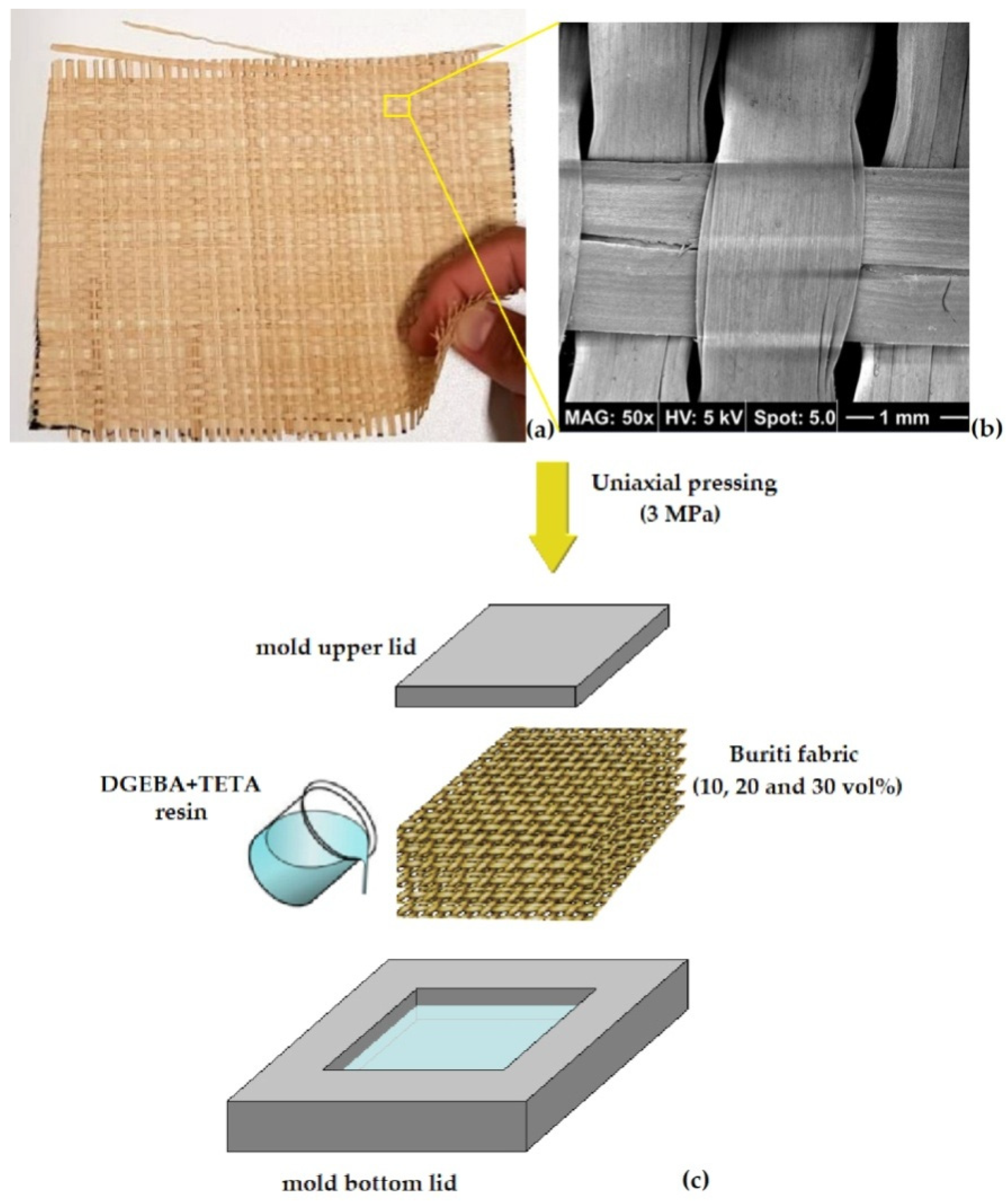
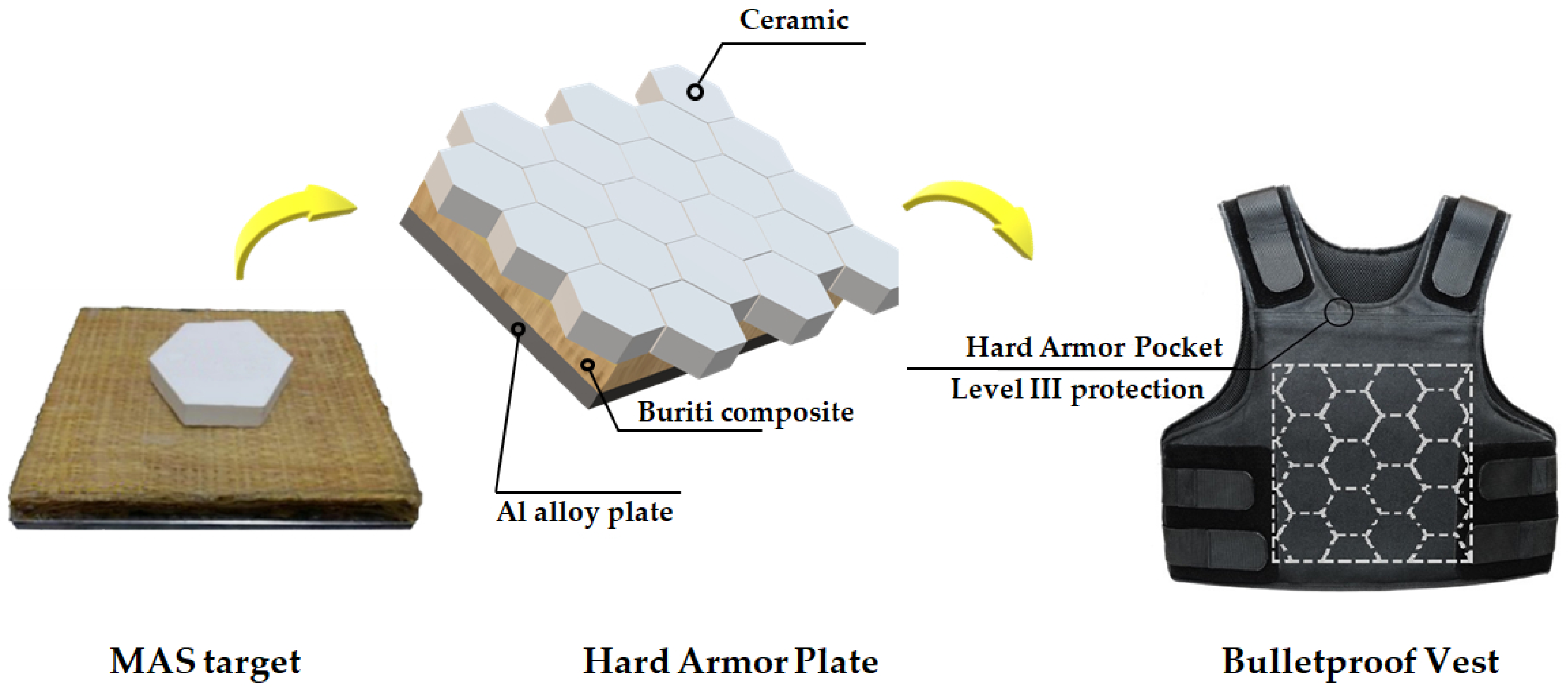
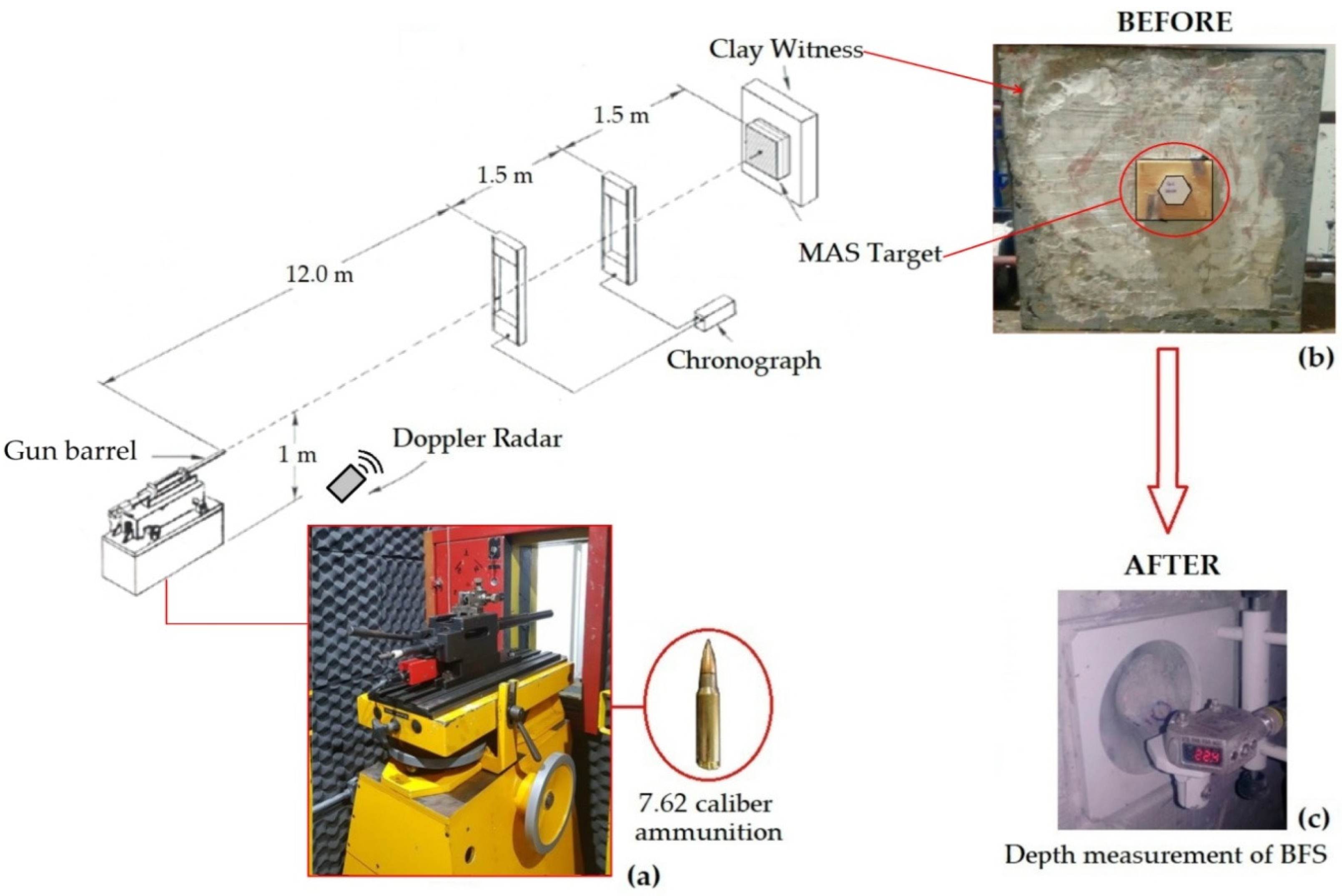
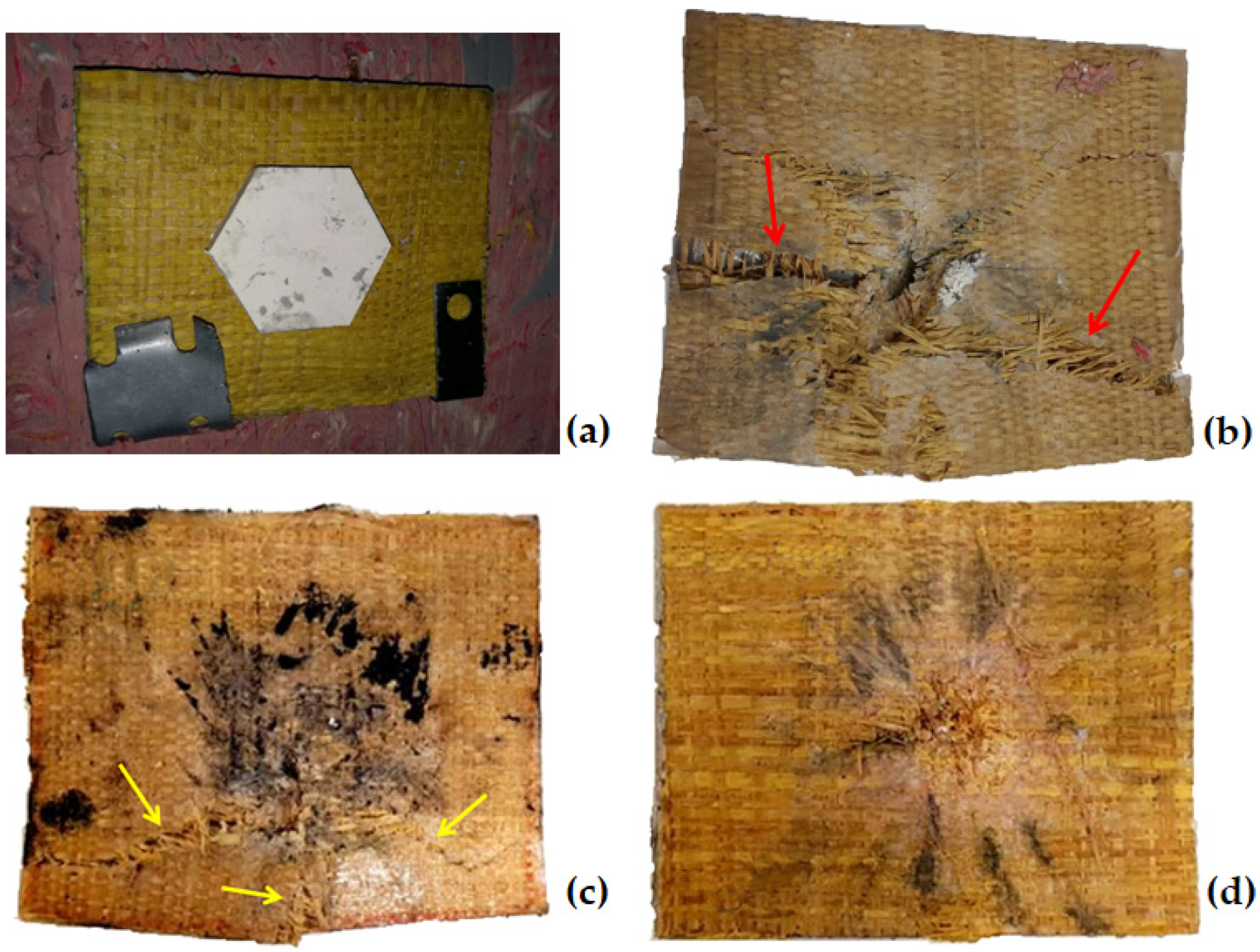
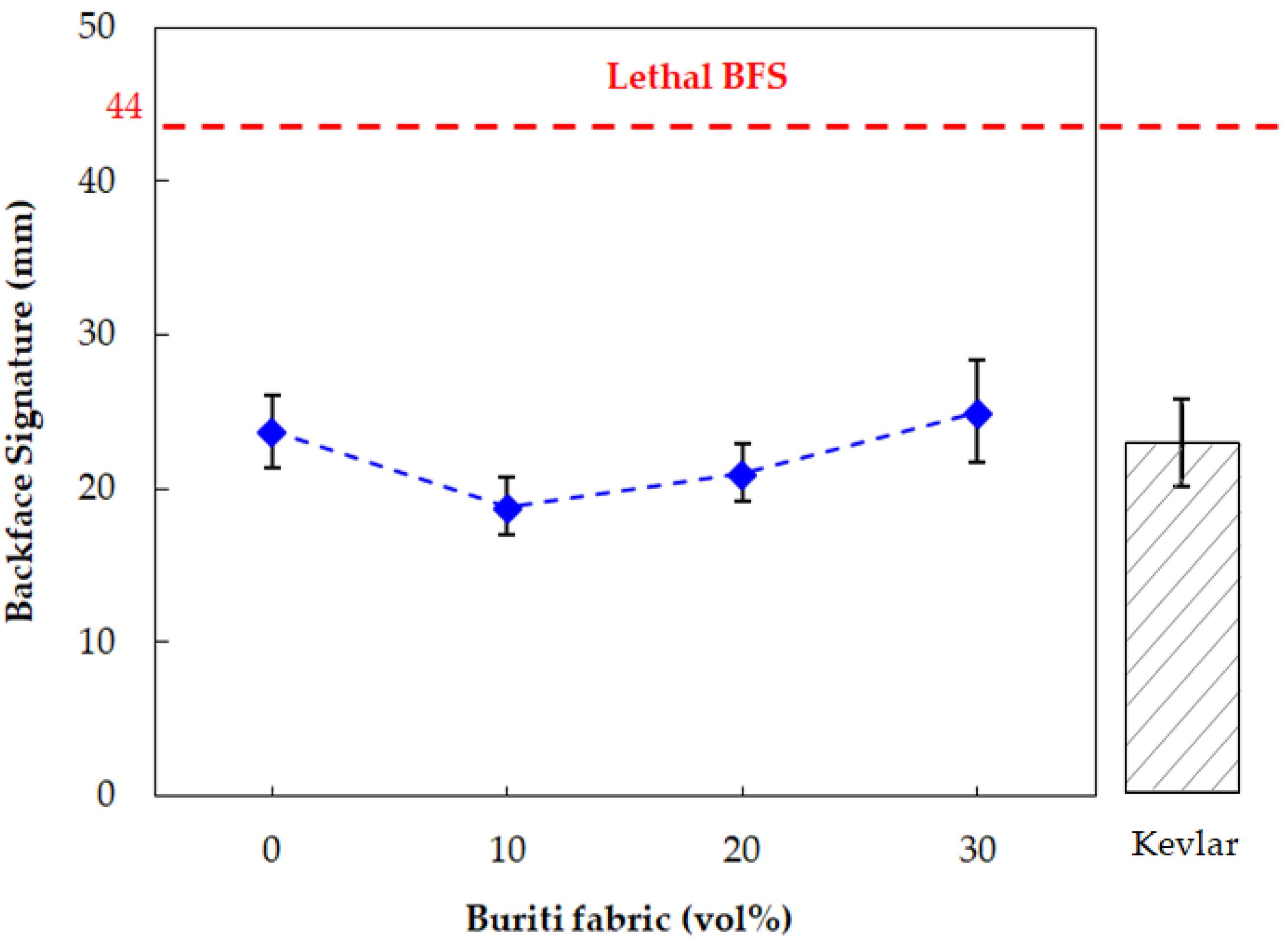
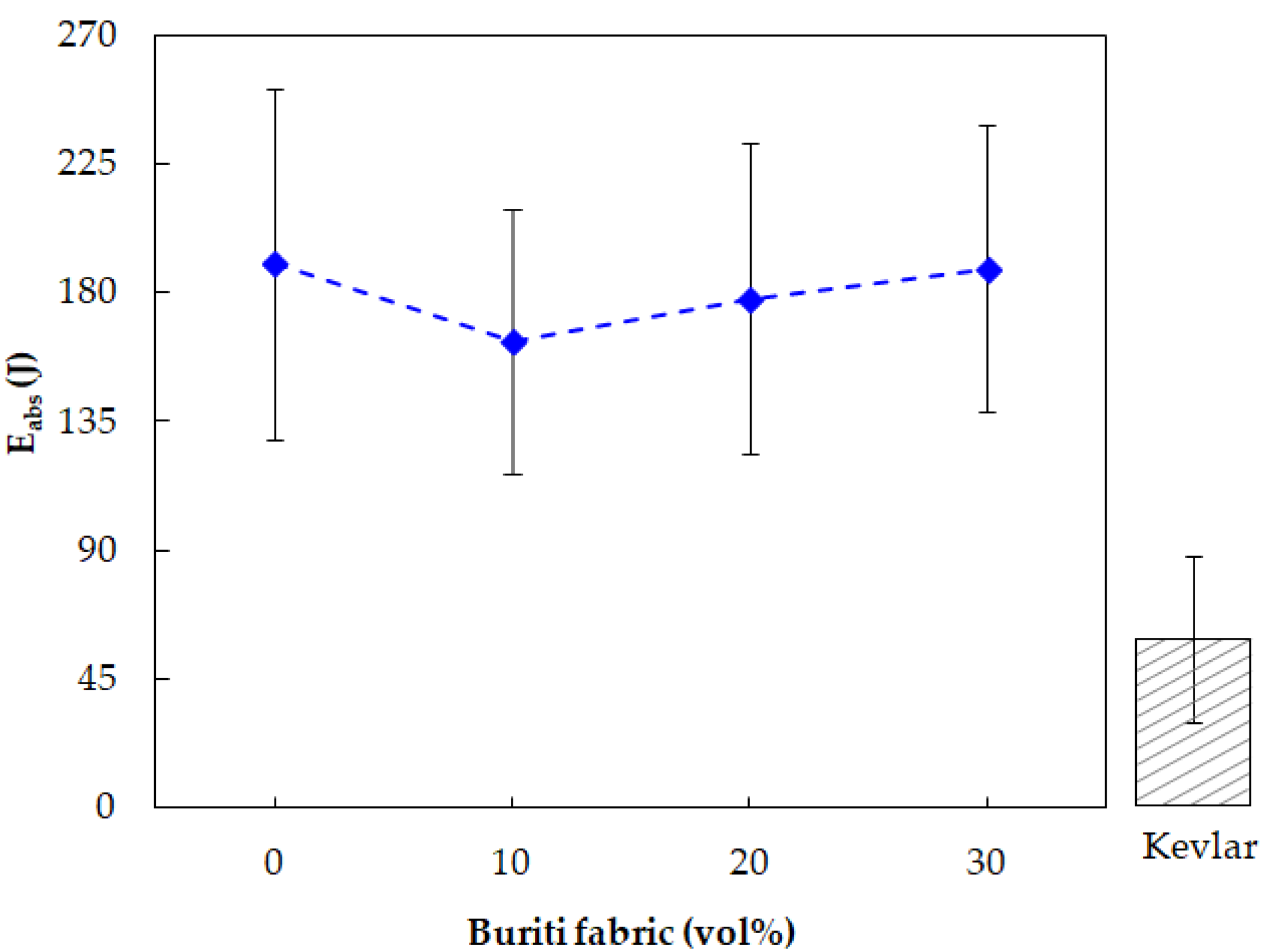
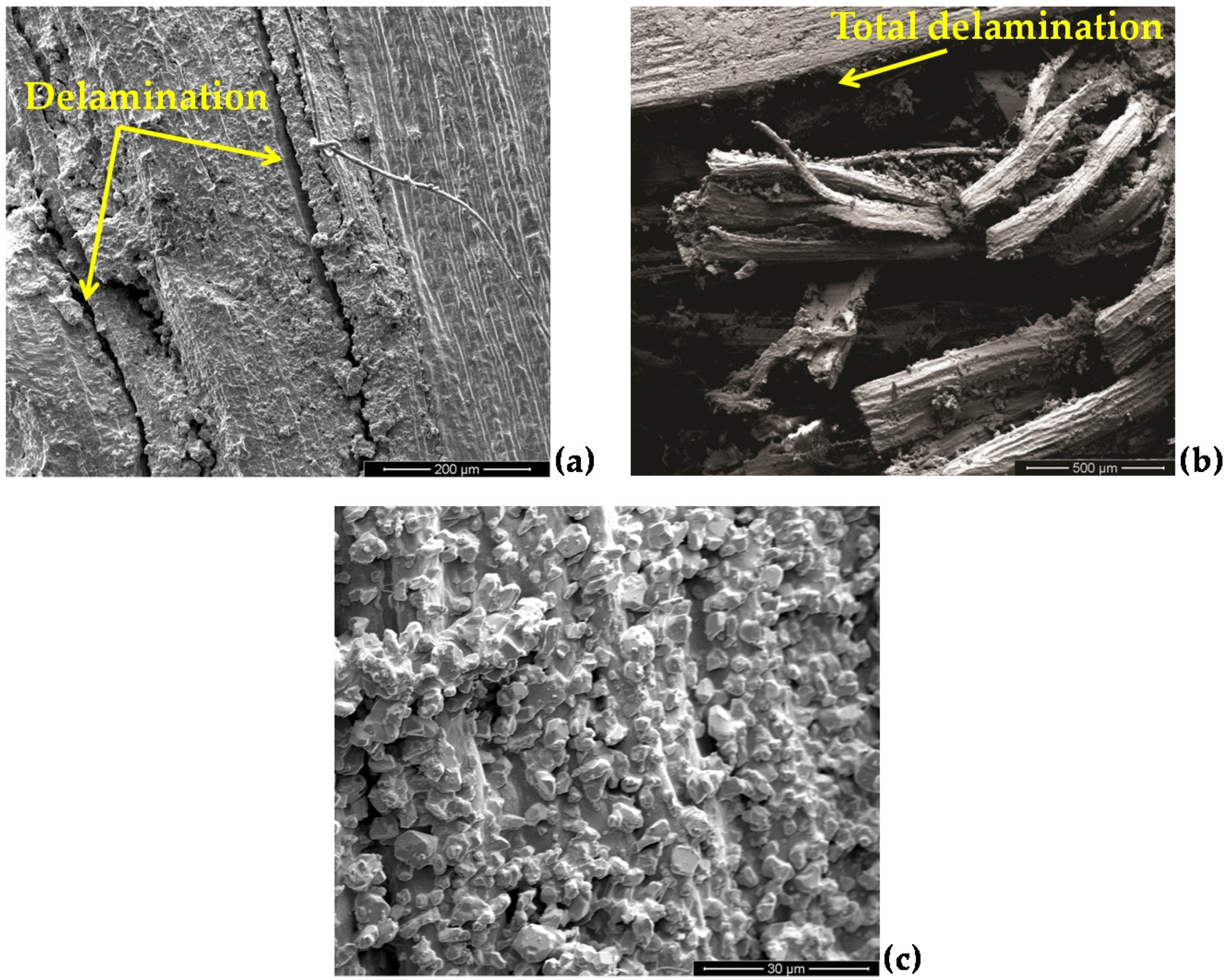
| MAS Second Layer | Depth of Indentation (mm) | Reference |
|---|---|---|
| Aramid fabric/Kevlar™ | 21 ± 3 | [56] |
| Ultra-high molecular weight polyethylene non-woven fabric/Dyneema™ | 41 ± 2 | [57] |
| 10 vol% buriti fabric/epoxy | 22 ± 4 | [54] |
| 30 vol% curaua non-woven fabric/epoxy | 28 ± 3 | [58] |
| 30 vol% jute fabric/epoxy | 21 ± 3 | [59] |
| Composite | BFS (mm) | Reference |
|---|---|---|
| EC10BF | 18.9 ± 1.9 | PW |
| EC20BF | 21.0 ± 1.9 | PW |
| EC30BF | 25.0 ± 3.3 | PW |
| Lethal BFS | ≥44 | [45] |
| Variation Causes | Sum of Squares | DF | Mean of Squares | Fcalc | Fcrit | p-Value | |
|---|---|---|---|---|---|---|---|
| ANOVA | Treatment | 210.88 | 3 | 70.29 | 11.82 | 2.90 | 2.26 × 10−5 |
| Residual | 190.37 | 32 | 5.95 | ||||
| Total | 401.24 | 35 | |||||
| Tukey Test | DF (Residual) | q (Tabled) | MSR | HSD | |||
| 32 | 3.84 | 5.95 | 2.96 | ||||
| Stand-Alone 10 mm Thick Plate Target | (m/s) | (m/s) | (J) | (m/s) | Ref. |
|---|---|---|---|---|---|
| EC10BF | 844 ± 6 | 824 ± 9 | 163 ± 46 | 182 ± 24 | PW |
| EC20BF | 840 ± 7 | 818 ± 6 | 178 ± 54 | 190 ± 30 | PW |
| EC30BF | 845 ± 9 | 823 ± 10 | 189 ± 50 | 194 ± 97 | PW |
| DGEBA/TETA epoxy | 850 ± 2 | 827 ± 6 | 190 ± 61 | 196 ± 32 | [50] |
| Kevlar (ply of aramid fabric) | 848 ± 6 | 841 ± 7 | 58 ± 29 | 109 ± 7 | [49] |
| Variation Causes | Sum of Squares | DF | Mean of Squares | Fcalc | Fcrit | p-Value |
|---|---|---|---|---|---|---|
| Treatment | 4275.82 | 3 | 1425.27 | 0.29 | 3.01 | 0.83 |
| Residual | 116,822.50 | 24 | 4867.60 | |||
| Total | 121,098.32 | 27 |
Publisher’s Note: MDPI stays neutral with regard to jurisdictional claims in published maps and institutional affiliations. |
© 2022 by the authors. Licensee MDPI, Basel, Switzerland. This article is an open access article distributed under the terms and conditions of the Creative Commons Attribution (CC BY) license (https://creativecommons.org/licenses/by/4.0/).
Share and Cite
Demosthenes, L.C.d.C.; Luz, F.S.d.; Nascimento, L.F.C.; Monteiro, S.N. Buriti Fabric Reinforced Epoxy Composites as a Novel Ballistic Component of a Multilayered Armor System. Sustainability 2022, 14, 10591. https://doi.org/10.3390/su141710591
Demosthenes LCdC, Luz FSd, Nascimento LFC, Monteiro SN. Buriti Fabric Reinforced Epoxy Composites as a Novel Ballistic Component of a Multilayered Armor System. Sustainability. 2022; 14(17):10591. https://doi.org/10.3390/su141710591
Chicago/Turabian StyleDemosthenes, Luana Cristyne da Cruz, Fernanda Santos da Luz, Lucio Fabio Cassiano Nascimento, and Sergio Neves Monteiro. 2022. "Buriti Fabric Reinforced Epoxy Composites as a Novel Ballistic Component of a Multilayered Armor System" Sustainability 14, no. 17: 10591. https://doi.org/10.3390/su141710591
APA StyleDemosthenes, L. C. d. C., Luz, F. S. d., Nascimento, L. F. C., & Monteiro, S. N. (2022). Buriti Fabric Reinforced Epoxy Composites as a Novel Ballistic Component of a Multilayered Armor System. Sustainability, 14(17), 10591. https://doi.org/10.3390/su141710591








